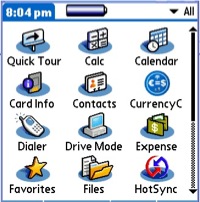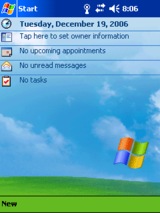

Inside the iPhone: Wireless and Sync vs. Palm, WinCE
The iPhone isn't just a standalone hardware device. It's an iPod, and like the earlier iPods, its integration with iTunes will provide it with a variety of advantages in the areas of sync, software installation, and simplicity.
Competing phones, from the Palm Treo to WinCE / Windows Mobile devices and phones from Nokia, Motorola, and other independent manufacturers all suffer from a variety of consistency problems that were outlined in Device Problems In Search of a Solution. In general, all lack:
-
•Consistent User Interface
-
•Consistent Stability
-
•Consistent Data Sync
-
•Consistent and Fair DRM
User interface and overall stability were considered in the last article: Inside The iPhone: UI, Stability, and Software. Here's a look at how the iPhone compares with Palm OS, WinCE, and other mobiles in the area of data sync services.
Solving Data Sync Problems
The third issue plaguing existing phones is the problematic sync services each provides. Most phones now include Bluetooth profiles that allow sync; these rely upon the built in Bluetooth services in Mac OS X or Windows. Actual sync involves more than what Bluetooth itself does however.
There are a stack of technologies required to support everything that falls under the general concept of sync. The most basic is a conceptual physical layer, representing the cable or wireless cable-equivalent used. For example, Bluetooth, the USB Dock, WiFi, and EDGE all provide paths for sync. Each offers a very different speed capacity.
Above that conceptual foundation, there also needs to be software support for sync protocols and an application layer which makes sure that files are not just pushed around, but elegantly managed in a useful way.
Various layers of this “sync stack” have to line up perfectly in order for things to “just work.” Without all these parts being engineered to work together seamlessly, the idea of sync begins to fall apart. What good is there in having Bluetooth or WiFi, if the ability to actually transfer any files with them is blocked?
Verizon phones may have “Bluetooth,” and Microsoft’s Zune has “WiFi,” but in both cases, those devices lack real support for doing the most useful things one would expect from those features. It’s like having a hammer that can do anything but hit nails.
Similarly, merely being able to plug a cable into a phone does not mean that it will magically sync as expected. The same applies to various wireless pathways: having a WiFi radio does not mean you can use WiFi to wirelessly do everything that can be done over a USB cable.
Defining the Kitchen Sync
Sync may seem like a simple idea, but under the surface it is deceptively complex. It takes a lot of engineering genius to build a simple sync system that seamlessly “just works.”
Phones have a variety of different needs that might fall under the general idea of sync:
-
•syncing of calendar and contact PDA information with a PC
-
•syncing of photos and movies captured on the device to a PC
-
•syncing of movies, photos, and songs from a PC media library for playback on the device
-
•syncing of software and firmware updates, and the data used by handheld apps, with a PC
Additionally, some phones also support: -
•downloading music, ring tones, video, or games directly from a network service or store
-
•syncing data with an online service, for access to email and other online data services
Different vendors have developed sync technologies that reflect their chosen business model: hardware vendors pursue strategies that sell units; service companies seek to sell minutes; software companies sell licensing.


How Palm Syncs and Thinks
Palm, like Apple, is a hardware company. Like Apple in the days of the classic Macintosh, Palm developed the minimal software necessary to support sales of Palm hardware, and then worked to build a vibrant third party development community to keep hardware sales moving.
Palm devices have always used the company's HotSync software to sync everything on the Palm to Palm Desktop software running on a computer.
In order to sync a Palm device with other applications, including Outlook on Windows, or Apple's iCal and Address Book on the Mac, users can install Palm conduits, which divert data headed to Palm Desktop to an alternative selection of apps on the computer instead.
How Microsoft Syncs and Thinks
Microsoft copied the idea of Palm's HotSync services and incorporated it into Windows under the name ActiveSync. Unlike Palm, Microsoft is a software company. ActiveSync software was developed to create a market for third party WinCE hardware devices, and tie them to Microsoft’s Windows software platform.
That in turn was intended to sell Microsoft’s OEM WinCE software licenses to the manufacturers of WinCE devices. End users can also pay to upgrade to a newer version of WinCE, if their devices supports the newer version.


That's the plan anyway. In reality, WinCE--and the various brands related to it, including Pocket PC, Smartphone, and Windows Mobile--has been a huge boondoggle for Microsoft over the last half decade.
WinCE problems, from a poor user interface design to its reliability issues, were described in the article Newton Lessons for Apple's New Platform. The product has not resulted in meaningful sales, particularly when compared to the massive development work that Microsoft has invested into the black hole of WinCE.
Microsoft's latest strategy involves plans to spin off the burden of further WinCE development to its hardware partners. It has recently downplayed WinCE, and instead focuses attention on a mobile version of its standard desktop Windows product under the names Origami / UltraMobile PC and Tablet PC. These have also been spectacular failures.
There is no Mac version of ActiveSync from Microsoft, but third parties have developed workalike products to sync WinCE devices with Macs and other platforms, including the Missing Sync.
Unlike Palm HotSync, which syncs on demand when a button is pushed, ActiveSync syncs constantly, whenever the device is plugged into its cradle. ActiveSync is also geared more to syncing with Exchange than providing comprehensive sync support.
How Other Phones Sync with Macs
Other phone makers, including Motorola, Nokia, Samsung, and Sony Ericsson, are all hardware vendors interested in unit sales. Before Bluetooth, each had to pay to develop or license custom software to sync with Windows or the Mac, typically providing some arcane bit of serial port garbage that didn’t really work.
They all did a really bad job of delivering this, because most hardware companies are lost when it comes to delivering integrated software. USB helped to introduce a simplified and consistent model, improving things dramatically.
Bluetooth went even further to define profiles, or standard ways to perform common tasks. Today, most phones commonly rely on standard Bluetooth PDA syncing profiles or semi-standardized USB sync protocols, both of which make syncing far more consistent across different brands of hardware.
Manufacturers are happy because they have less unique software to write, and users benefit from an open market with fewer barriers to choice. The only companies who don’t like Bluetooth are certain mobile service providers like Verizon, who want customers to pay to use their own network to move data around.


Bluetooth and USB sync rely on the native syncing services available on a computer’s operating system. Apple jumped to support Bluetooth on the Mac because it leveled the playing field; Apple could write most of the software for phone makers, and suddenly gain Mac support for a wide variety of third party phones.
Apple further developed Sync Services for Mac OS X, which are designed to sync with Palm's HotSync via a special Palm conduit; a variety of standard Bluetooth sync profiles; a supported set of USB phones; as well as Apple's own iPod and .Mac online services.
Real World Palm Sync Issues
As they say, “in theory, theory and practice are the same. In practice, they are not.” Looking at a list of Palm OS bullet points does not convey how things really work. Here’s a review of Palm’s sync, based on a decade of use.
Contact and Calendars: Although it does a decent job of syncing with Outlook on Windows, the Palm Treo struggles to sync with the Mac using Palm’s clumsy and dated Mac version of Palm Desktop. For example, the Palm can't sync or even import contact photos from Address Book.
HotSync doesn't directly sync with Mac OS X's Sync Services, although Apple supplies its own conduit for the Palm HotSync system, which diverts contacts and calendars from the Treo into Address Book and iCal.
Sync becomes increasingly more complex when multiple devices are being synced together, primarily when devices support different types and layout of data. For example, different limits on the amount of data stored in a given contact field can cause problems.
Things get even worse when multiple sync databases are involved. Mixing HotSync and Sync Services together makes duplicate records a common problem, because both systems attempt to reconcile data differently.
Exchange Server To further complicate matters, one can throw in synchronization with Exchange Server. The Palm Treo added live support for Internet sync with Exchange, as opposed to simply syncing with a desktop PC. The complication is that a device can only reliably sync with one or the other.
Syncing directly with a PC is the most straightforward, but updates to and from Exchange only happen during a cradle sync. To maintain a live, updated copy of what’s on the server, the Treo has to connect with Exchange via the Internet. It does this through Outlook Web Access, just like Apple’s Exchange integration in Mac OS X.
When syncing over the Internet with Exchange, Palm turns off the conduits for syncing calendars and email with Outlook on a PC directly. Having two different sync systems trying to sync three pools of data (the handheld, a PC, and the server) would cause major problems.
Even so, I’ve found the network sync between both the Palm Treo and Microsoft’s own WinCE devices only work for about a month or two before running into an error that requires the user to delete the handheld’s email and calendar and start over. This is not really cool in a business setting, where emails might be important.
Camera Photos and Movies: Palm HotSync does not sync photos or video taken by the Palm Treo camera into iPhoto like a normal digital camera would. Instead, it secretly dumps photos taken by the Treo’s camera into folders that users have to locate and manage manually.
For example, my Treo decided to create the folder ~/Pictures/palmOne Photos/daniel/Expansion Card 3FA1, along with a separate Internal folder next to it, to store synced copies of the photos on my Treo and on its expansion memory card. Movies are similarly dropped in parallel locations, far far away, buried under ~/Movies.
These folders were apparently chosen in order to celebrate Palm’s corporate name-of-the-day, the serial number of the memory card I had to install to make up for the Palm’s pathetic internal storage, and the delightful humor of some corporate drone programmer trapped in the bowels of a profoundly incompetent tech company.
Touché, Palm. Thanks for laughing at my expense! The next one is on you, seriously.
Photos, Video, and Music It's no easier to put photos on a Palm from iPhoto, but Palm doesn’t include much of a photo browser anyway, so there is little point. In fact, putting photos on a memory card to view them on the Treo is a fine way to crash the photo viewer, turn off the phone, and auto reboot the Palm OS.
There are many other ways to do this, too of course.
Despite all the banter about how supposedly “smart” phones would obsolesce the iPod simply by adding music and movie playback features, the Palm Treo doesn't sync songs and movies with iTunes either. Once again, its support for music playback is rather weak, anyway, and it of course can’t play any real movies, to boot.
Palm sells a LifeDrive device that purports to offer more media centric features, but at this point, I’m not really excited about anything from Palm. If, after ordering a Filet-o-Fish, I was served an old shoe between two sesame seed buns, I’m not likely to try the Big Mac.
Say goodnight, Palm.
Software and Firmware Updates: Palm has also delivered a clumsy and problematic software sync platform. Installing applications isn't usually difficult, but apps frequently get messed up on sync, and must be reinstalled.
The Palm's legacy--including limited working memory and storage capacity, and the absence of multitasking--just makes things worse. If the device runs out of memory it simply refuses to sync, requiring users to manually dig around to get things working again, or reset the device to factory defaults and start over without their data.
In addition, performing a firmware update on Palm hardware is an arcane and bizarre feat, involving pages of convoluted instructions listed on Palm’s website.
Palm packs various adware and junk into its default Treo software packages, which varies depending on which vendor is reselling the unit. This offers another hint as to why Apple launched the iPhone with a single provider.
Network Services and Online Stores: One example of embedding unremovable trashware into the Palm system image is the concession that allowed Verizon to hijack Palm’s native sync system to force data over Verizon’s own network to sync with Verizon’s servers, rather than syncing directly with the user's local PC.
Other providers install an adware tool to enable users to buy Palm applets via a download over their network. These are clunky and unusable, and further complicate the already overextended and messy state of Palm sync software and the Palm platform in general.
We Don’t Want Your Business
It's almost like Palm has been actively trying to alienate Mac users. Had Palm offered a native update to fully support Sync Services, it could have built up a strong user base of devoted Mac clients. Instead, it has actively pushed Mac users away, creating a vacuum that begs for something that works.
Microsoft has similarly snubbed Mac users with its Windows-only ActiveSync for its WinCE devices, including Windows Mobile phones. While Macs only make up around 2% of the world’s PCs, Mac users buy nearly a fifth of America’s software, and currently represent 12% of the domestic laptop market by unit (not dollar) sales.
That’s saying something when Mac laptops start at around $1100, and PC laptops (admittedly of much lower quality) are commonly available in the $600 range. Snubbing Mac users is particularly a poor strategy when trying to sell devices that fit into a category that drifts into “expensive toy” territory.
Part of the reason why the iPod sold quickly was because it initially targeted Mac users, who tend to be more willing to pay more for things they want. Microsoft snubbed Mac users with the Zune. It was certainly not the only mistake made in trotting out Microsoft’s ultimately ineffectual iPod Killer, but didn’t help things at all either.
Getting the Phone
While I have have less experience in owning WinCE devices, I am occasionally forced to figure out what went wrong with clients’ WinCE units: why the calendar stopped syncing with Exchange, where Microsoft buried some feature deep within its horrific UI. Every encounter has left me deeply scarred. I am not a fan.
Given the brief overview of Palm’s bumbling incompetence--and Microsoft’s arrogant incompetence--how could anyone think that Apple would be challenged to improve upon things in the premium mobile phone space?
Palm CEO Ed Colligan recently stated that Apple would be hopelessly stymied in its efforts to build a rival phone platform. Of course, that was before Apple demoed the iPhone. He is unlikely to make similar comments again.
No doubt what he intended to say was that, while anyone can build phone hardware, the real trick is getting the software right. A significant part of that challenge comes from delivering elegant sync services that work.
Apple's Existing Sync Services
It's true that it is very hard to get sync right on the first try. As noted earlier, sync services were a major stumbling block for the Newton. However, Apple has been actively working on sync since iSync appeared in Jaguar back in January 2003. 

Apple has already improved upon the Palm's sync features with its existing iPods. On both the Mac and Windows, iTunes offers simple but powerful sync features that support:
-
•effortless PDA data syncing with Mac OS X's built in Sync Services, or Windows’ Outlook.
-
•photo support for iPods using the camera connector (existing iPods don’t take photos, but can store them)
-
•automatic or manual control of music and video syncing from the iTunes library (including Podcast support)
-
•ultra simple software updates and installation (the Nike+ and iPod games, for example)
By default, Sync Services uses iCal for scheduling and Address Book for contacts, but any application can plug into Sync Services; Microsoft released sync conduits for users who prefer to use Entourage, for example.
Sync Services also plugs into .Mac, so subscribers can maintain a copy of their synced data that is available from any web browser, or which can be synced between different computers. This is optional in the “really optional” sense, unlike Verizon’s “sync with us or else” model.
Apple and Bluetooth
Apple has also developed Bluetooth support for a variety of phones and other devices, making it easy to configure a range of Bluetooth services:
-
•dial up networking, to use a Bluetooth phone as a modem to access the Internet
-
•file transfer and exchange, to act as a file server or manually copy files between Bluetooth devices
-
•PDA sync, to automatically set up a secure data sync using Bluetooth
-
•support for printers, headsets, input devices, and other Bluetooth peripherals
If Apple already supports these services for other makers' phones--some of which only support a subset of those features--it no doubt sees the value in those services and will incorporate them into its own phone.
Expanded iPhone Sync: Bluetooth, EDGE, WiFi?
Like existing iPods, the iPhone will similarly offer native syncing with Sync Services though iTunes. New features in Leopard, including Mail's vastly improved Notes and To Do events system, will also sync to the iPhone.
Apple can seamlessly deliver this without requiring users to find third party apps or doodle with the oddball custom software like the Palm's stagnating HotSync and its various problematic and conflicting extensions.
Will the iPhone sync via Bluetooth? Will it sync via WiFi or EDGE? Will it order songs and movies from the iTunes Store directly, from anywhere? Well... sometimes things that sound like good ideas actually aren’t.
Full Bluetooth sync would be awfully slow; Apple might support a limited PDA sync profile, as well as supporting file transfers, dial up networking, and perhaps use of the iPhone as a remote control device--which is also part of the Bluetooth spec--the way Salling Clicker already does. If Apple does not, no doubt Salling will.
In addition, despite being designed for low power devices, Bluetooth sync would consume a lot of battery. When syncing my previous Sony Ericsson phone over Bluetooth, I could actually watch the battery level going down.
Why Try WiFi Sync?
As for WiFi sync, while it can run up to ten times faster than Bluetooth, it is still very slow compared to a USB 2.0 Dock connection. Using Cingular’s EDGE would, of course, be even slower.
Why sync wirelessly at ideally 20 Mb/sec and drain the battery using WiFi, when a USB dock sync approaches 400 Mb/sec, and charges the battery? After a more than five times slower WiFi sync, you'd have to dock it to recharge anyway because your battery would be half dead.
Today, mobile phones commonly only sync a bit of PDA calendar and contact data. The iPhone has a large 4 or 8 GB capacity, and begs to be full of photos, movies, HTML emails, Notes, and other stuff. USB sync simply makes far more sense. Bluetooth, EDGE, and WiFi have compelling uses, but sync isn't really one of them.
A Mobile iTunes Store? Nope!
Everyone likes to talk about being able to download songs while walking around, as if this would be a killer application for mobile phones. These people are either uninformed, or have something to sell.
It's primarily the mobile service providers who like the idea of users downloading music wirelessly. They're service providers, so they want to find ways to sell service. Apple isn't a service provider, it's a hardware company. It wants you to buy an iPhone, not to run up a big service plan bill.
Buying iTunes over EDGE would be ridiculously slow--and expensive, unless you had an all-you-can-eat service plan. WiFi would be reasonably fast, but would also hit the iPhone's battery hard. And for what? To allow users to buy a song while sitting in a restaurant with a WiFi hotspot? To buy songs wirelessly at home next to their PC?
The point of having a decently large mobile library is not needing to buy anything: you can take your own stuff with you. Further, only a small percentage of iPod users buy from the iTunes Store in significant quantity now.
Will having the additional expense and inconvenience of a slower wireless connection, paired with a limited, handheld version of the iTunes Store suddenly make buying online more attractive? How ruthlessly absurd!
Who would want to order and download any significant amount of data over the phone's WiFi, when it can be found far faster and more conveniently using iTunes on a desktop computer? The real problem with WiFi store access is not a speed issue--WiFi is faster than typical broadband Internet--but one related to DRM.
The next article explains why, as part of a look at how the iPhone will solve DRM issues on existing phones.
Next Articles:
This Series


 |
|
 |
|
 Del.icio.us |
Del.icio.us |
 Technorati |
About RDM :
:
Technorati |
About RDM :
:

Wednesday, January 17, 2007





 Send Link
Send Link Reddit
Reddit NewsTrust
NewsTrust






